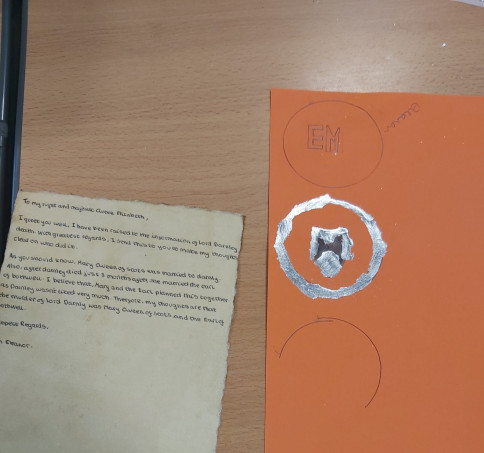Many congratulations to Dr Claire Bartram for gaining TWO IHR Centenary Partnership Event grants, this is fantastic news: https://www.history.ac.uk/our-century/centenary-partnership-events and please see details below.
These IHR partnership events will turn from July this year until May next year and all approach history in imaginative and creative ways. Of Claire’s two grants, one involves a collaboration with partners outside CCCU’s CKHH and features Canterbury’s Medieval Pageant and Trail: https://www.history.ac.uk/our-century/centenary-events/canterburys-medieval-pageant-and-trail-thomas-becket-project while the other involves participants from within the School of Humanities and Education Studies and is spearheaded by the Centre: https://www.history.ac.uk/our-century/centenary-events/imagining-dover-a-digital-exhibition-creative-resources exploring and engaging with the idea of ‘Dover’. Thus, the online exhibition will include pre-recorded talks on the medieval and more recent history of the town, site-specific creative writing activities, podcasts and blogs. News about the exhibition will feature in the Centre’s blog over the summer, as well as elsewhere on the CCCU website.

As a final reminder about the ‘In conversation with Dr Marc Morris’ event on Tuesday 25 May at 7pm on Teams Live Events, this will feature his new book on the making of England before the Norman Conquest. The public online event is free and booking is not required. Please note this is the joining url: https://teams.microsoft.com/l/meetup-join/19%3ameeting_MjI5YThhZTItMWUwZC00YjhjLTlmZjItOTQwODlkMzcwYTFh%40thread.v2/0?context=%7b%22Tid%22%3a%220320b2da-22dd-4dab-8c21-6e644ba14f13%22%2c%22Oid%22%3a%225438ffb7-ff66-44f6-9ccf-cf504309571b%22%2c%22IsBroadcastMeeting%22%3atrue%7d&btype=a&role=a For those interested in buying Marc’s book, the CCCU Bookshop is getting in more copies, which will be signed by the author, please see: https://bookshop.canterbury.ac.uk/
Turning to other exciting events this week, Dr Diane Heath and I attended a meeting on Monday about planning the Faversham Magna Carta Exhibition, but more on that later this month. Instead, I’m going to concentrate on the Lossenham project and then move to Grace Conium’s presentation to the Kent History Postgraduates group about her research topic. As you will see there is considerable overlap between these two topics.
Monday saw a meeting of the Lossenham project wills group on Zoom to evaluate collectively the pilot project we had been doing on PCC wills from certain parishes where the pairs or small groups had been entering information on the spreadsheet designed by Sophie, Rebecca and Jane. For we wanted to decide whether the amount of detail captured from the wills was too little to be useful or too much because of the length of time it takes. Linked to this, we had a fruitful discussion concerning whether we need all the fields we currently have, and to think which are the most useful. Furthermore, as archives begin to open up – we decided to be positive here – should wills continue to be the core source, specifically the PCC ones? This sparked a helpful conversation, and it became clear that some members of the group were now in a better position to identify topics they want to pursue. Others have yet to decide and are happy to continue expanding the pilot spreadsheet. However, before this happens Sue, Rebecca and Jason will have a discussion about the changes which would make sense to enhance the spreadsheet’s value to the group and potentially other project researchers. In addition, Jason has volunteered to concentrate more on inputting with others providing rough transcripts as a way to increase the group’s efficiency.

Just as a way of giving you an idea of the topics people within the group are interested in and thus the potential of these sources as a great starting point, Sophie, Sara and Jane are going to work together on the pre-Reformation wills from the diocesan courts now that the Kent History Library Centre has reopened at Maidstone to explore lay piety and bequests to religious houses. Obviously the Carmelites at Lossenham is the priority and thus their target, but they are also interested to find out what other religious houses in this area and further afield were places local people wished to patronise. Moreover, as the PCC Newenden wills showed, it is equally possible to pick up named Lossenham friars, albeit only their forenames. Similarly, it will be interesting to see what can be found out from the wills about the parish church, its chapels, altars and fraternities, as well as where people wished to be buried.
Another theme that has excited some members of the wills group is families in the area. Furthermore, wills often offer good information not only about blood and affinal kin, but the kinship links people had through godparenting. Annie and Sue will be exploring this topic, while the other Sue has a specific interest in Rolvenden and will therefore follow this up, firstly through the PCC wills before also looking to the lower court registers.
We have several more action points that we agreed on together, but hopefully this has given you a taste of what is happening. I know Dr Andrew Richardson is intending to start on the field work in June, for details if you have signed up, please see the project’s next newsletter, and if you haven’t and would like to get involved as a volunteer, please email Annie Partridge, also of Canterbury Archaeological Trust at Annie.Partridge@canterburytrust.co.uk

I am going to be briefer about the second meeting of this project I attended this week, but I would like to wish Dr Helen Clarke, who has been chairing the Lossenham History Group until now, a speedy recovery and the group are looking forward to seeing her again in the autumn. In her temporary absence, I will take over the chair but as we decided this on Tuesday Andrew chaired this particular meeting. To a degree the documentary history has taken the lead in terms of engaging volunteers so far because of COVID restrictions for the field work, but this will change over the summer as Andrew and others, with the volunteers, become engaged in various archaeological activities at Lossenham and surrounding area. Thus, the History Group membership and its role was discussed this week reaching a consensus that we would aim to see ‘History’ in this context holistically, the group’s members coming from their own areas but recognising that this is a multi/interdisciplinary community research project. Similarly, we came to an agreement that as a group we are now in a position to formulate some overarching questions that we want to tackle from the knowledge we have currently. This we have set ourselves as an aim for our next meeting in June, understanding that, of course, we are going to be to a considerable extent led by the evidence we find – it is no good having ‘great’ research questions if the evidence isn’t there and never will be. Furthermore, we agreed such steering would be valuable, not only for us but for the volunteers right across the project, communication being a two-way process: between the History Group and the specialist groups, as well as within the specialist groups (the documentary/wills group or the finds group that Andrew is envisaging), for we can all learn from each other. I think this is a good place to be at this stage and it will be interesting to see what the summer brings on all the different fronts. And to that end, there was broad agreement that next spring the project should have a 2-day event, perhaps using the format of the Medieval Settlement Research Group, ie short presentations on one day that explore the area’s past in a wide range of ways, drawing on findings from the previous year’s research, and then an excursion in the area on the second day – guided walks or similar, with a small exhibition offering further information and ideas. This is all very exciting and it will be fascinating to see how everything develops.

This brings me to Grace’s presentation on her AHRC-funded doctoral research project which is a joint venture between CCCU and MOLA. Grace is supervised by Dr Ellie Williams and Professor Peter Vujakovic, thereby again showing the value of multi/interdisciplinary projects because Ellie is from Archaeology and Peter from Geography. Grace is in her first year of research into how to evaluate most usefully community archaeological projects and her case studies will draw on several of these projects in east Kent coastal towns. In part this is because some coastal places in Swale, Thanet and Shepway are among the most deprived areas in England, which means that for funders such as the HLF these places are seen as a priority. As Grace demonstrated just such a funded project was the CITiZAN project because it included several places on the east Kent coastline and was intended to engage local people to become volunteers to survey the changing coastline, changes to heritage and the impact of climate change. For the volunteers, the experience was enhanced through the provision of training, much of which was conducted on the foreshore to show them what sorts of changes in the environment they should be looking for.
As Grace explained, this nationwide project offers a very large-scale enterprise, and she has also been exploring the far smaller ‘Finding Eanswythe’ HLF-funded project run by CCCU and CAT that included outreach activities involving re-enactors and a churchyard survey, but all of this has required her to try to define exactly what is community archaeology. For there seems to be no accepted definition and the vocabulary used appears to differ between projects. Equally, there can be a degree of confusion among the volunteers, but there is an acceptance among some that the sense of place is a crucial matter. For this idea of locality seems to engender a sense of belonging that can be strengthen through other factors, but it is not solely locals who become volunteers, and community may relate to a shared ethnic identity or interests in common.

This brings me to Grace’s dilemma. If she is to understand community archaeology and its value to different constituencies within society, she needs a method to measure what is often a combination of quantitative and qualitative responses to items like questionnaires. Moreover, there often remain problems of determining the degree of impact of the project studied, as a whole or of its parts, as well as the need to capture how far such projects are, for example, more top-down rather than bottom-up. Grace is seeking to capture all of these factors within a workable matrix that can be deployed to measure a range of community archaeology projects, and currently she has adapted one that was developed to assess individual items in a museum’s collection.
This was fascinating and sparked a considerable debate among the postgraduates present. For example, Janet has been heavily involved in her local archaeology group which is not funded by outside bodies and thus has far greater autonomy. A related issue she highlighted from Grace’s presentation was the tension that can sometimes develop between the professional archaeologists, often from outside the area, and the local volunteers, especially when these volunteers are highly experienced. Maureen too, mentioned the problems that such local research projects can face when different groups want to adopt different approaches in their dissemination of the project’s findings. This was echoed by Lisa from her experience, and she was also able to draw on work undertaken in the United States. Another related matter was pointed out by Pete that in some projects there had been poor communications which had meant what the leaders thought the volunteers wanted was not actually the case. This could lead to tensions and the potential for splits among the project’s personnel. Other topics were discussed too, and the audience’s interest in Grace’s presentation could be gauged by the fact that her 20-minute presentation generated a session of almost 80 minutes! So thanks very much Grace and everyone else who joined in this discussion; and next week we shall be going back in time to the period between the fall of the Roman Empire and the Norman Conquest.
 Centre for Kent History and Heritage
Centre for Kent History and Heritage Sheila Sweetinburgh
Sheila Sweetinburgh 1540
1540

